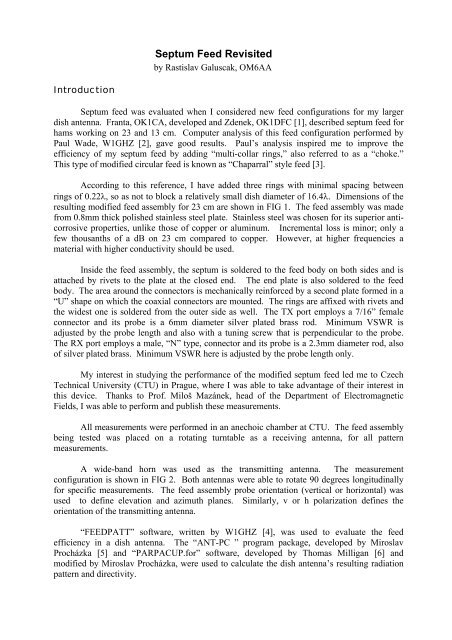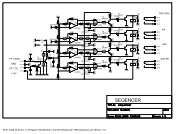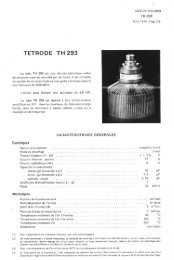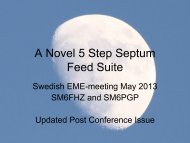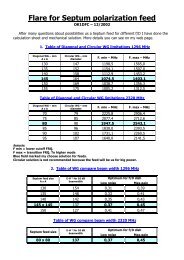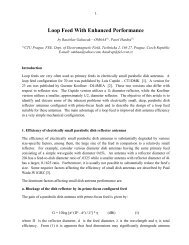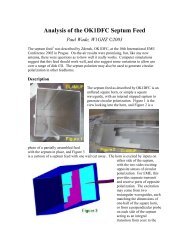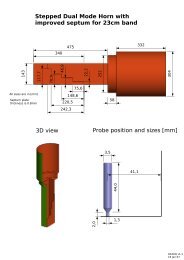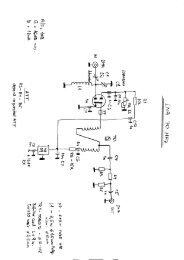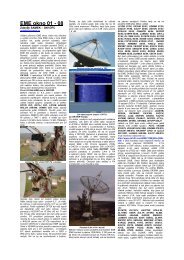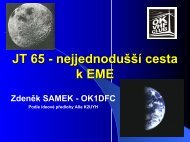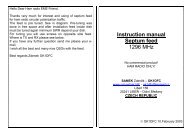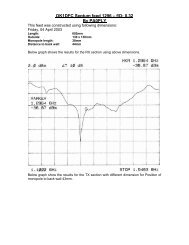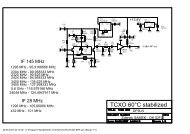Septum feed revisited - Ok1dfc.com
Septum feed revisited - Ok1dfc.com
Septum feed revisited - Ok1dfc.com
Create successful ePaper yourself
Turn your PDF publications into a flip-book with our unique Google optimized e-Paper software.
<strong>Septum</strong> Feed Revisitedby Rastislav Galuscak, OM6AAIntroduction<strong>Septum</strong> <strong>feed</strong> was evaluated when I considered new <strong>feed</strong> configurations for my largerdish antenna. Franta, OK1CA, developed and Zdenek, OK1DFC [1], described septum <strong>feed</strong> forhams working on 23 and 13 cm. Computer analysis of this <strong>feed</strong> configuration performed byPaul Wade, W1GHZ [2], gave good results. Paul’s analysis inspired me to improve theefficiency of my septum <strong>feed</strong> by adding “multi-collar rings,” also referred to as a “choke.”This type of modified circular <strong>feed</strong> is known as “Chaparral” style <strong>feed</strong> [3].According to this reference, I have added three rings with minimal spacing betweenrings of 0.22λ, so as not to block a relatively small dish diameter of 16.4λ. Dimensions of theresulting modified <strong>feed</strong> assembly for 23 cm are shown in FIG 1. The <strong>feed</strong> assembly was madefrom 0.8mm thick polished stainless steel plate. Stainless steel was chosen for its superior anticorrosiveproperties, unlike those of copper or aluminum. Incremental loss is minor; only afew thousanths of a dB on 23 cm <strong>com</strong>pared to copper. However, at higher frequencies amaterial with higher conductivity should be used.Inside the <strong>feed</strong> assembly, the septum is soldered to the <strong>feed</strong> body on both sides and isattached by rivets to the plate at the closed end. The end plate is also soldered to the <strong>feed</strong>body. The area around the connectors is mechanically reinforced by a second plate formed in a“U” shape on which the coaxial connectors are mounted. The rings are affixed with rivets andthe widest one is soldered from the outer side as well. The TX port employs a 7/16” femaleconnector and its probe is a 6mm diameter silver plated brass rod. Minimum VSWR isadjusted by the probe length and also with a tuning screw that is perpendicular to the probe.The RX port employs a male, “N” type, connector and its probe is a 2.3mm diameter rod, alsoof silver plated brass. Minimum VSWR here is adjusted by the probe length only.My interest in studying the performance of the modified septum <strong>feed</strong> led me to CzechTechnical University (CTU) in Prague, where I was able to take advantage of their interest inthis device. Thanks to Prof. Miloš Mazánek, head of the Department of ElectromagneticFields, I was able to perform and publish these measurements.All measurements were performed in an anechoic chamber at CTU. The <strong>feed</strong> assemblybeing tested was placed on a rotating turntable as a receiving antenna, for all patternmeasurements.A wide-band horn was used as the transmitting antenna. The measurementconfiguration is shown in FIG 2. Both antennas were able to rotate 90 degrees longitudinallyfor specific measurements. The <strong>feed</strong> assembly probe orientation (vertical or horizontal) wasused to define elevation and azimuth planes. Similarly, v or h polarization defines theorientation of the transmitting antenna.“FEEDPATT” software, written by W1GHZ [4], was used to evaluate the <strong>feed</strong>efficiency in a dish antenna. The “ANT-PC ” program package, developed by MiroslavProcházka [5] and “PARPACUP.for” software, developed by Thomas Milligan [6] andmodified by Miroslav Procházka, were used to calculate the dish antenna’s resulting radiationpattern and directivity.
FIG.1 Modify septum <strong>feed</strong>
The following measurements have been performed:I. Impedance Match at RX and TX PortsII. Impedance Match Changes against a Conductive PlateIII. Comparison of Radiation Characteristics at RX and TX PortsIV. Radiation Patterns at both Ports with Various Choke PositionsV. Feed Pattern Frequency DependencyVI. Isolation Between PortsVII. Phase Center PositionI. Impedance Match at RX and TX Ports.Measurement condition: Choke flush, free space.An ANRITSU S400A Site Master transmission line and antenna analyzer was used forthese measurements. Results are shown in FIG 3.
FIG 3Feed VSWR/50 Ohm32,82,62,4VSWR2,221,81,61,41,211200 1220 1240 1260 1280 1300 1320 1340 1360 1380 1400f (MHz)RX port, N connectorTX port, 7/16" connectorThe return loss at the RX port is about 40 dB. This very good impedance match can beviewed as a trade-off for narrower bandwidth. A return loss 33 dB was achieved at the TXport, with wider bandwidth.II. Impedance Match Changes against a Conductive Plate.Measurement condition: Choke flush.These measurements were made to investigate VSWR changes that may be encounteredwhen assembling the <strong>feed</strong> to a dish. A 1m x 1m conductive plane plate positioned normal tothe <strong>feed</strong>’s longitudinal axis was used to simulate the dish. The distance between the <strong>feed</strong> andplate was varied from 50 cm to 90 cm. The resulting VSWR performance is shown in FIG 4and FIG5.
FIG 4Impedance Match Changes against a Conductive PlateRX port50 cm 60 cm 70cm 80 cm 90 cm free space21,8VSWR1,61,41,211200 1220 1240 1260 1280 1300 1320 1340 1360 1380 1400f (MHz)FIG 5Impedance Match Changes against a Conductive Plate1 x 1 m, TX port50 cm 60 cm 70cm 80 cm 90 cm free space21,8VSWR1,61,41,211200 1220 1240 1260 1280 1300 1320 1340 1360 1380 1400f (MHz)At distances over 90 cm, VSWR changes were negligible.Shorter distances between the <strong>feed</strong> and conductive plane simulate the effects of a deeperand smaller dish. At these shorter distances, VSWR ripple was observed. This indicates thatwhen assembling the <strong>feed</strong> to a deeper and smaller dish, probe length adjustments may benecessary.
III. Comparison of Radiation Characteristics at RX and TX Ports.Measurement condition: Choke flush.These measurements, which <strong>com</strong>pare radiation patterns at both ports, gave the firstindication of <strong>feed</strong> circularity. Radiation patterns were measured with vertical <strong>feed</strong> orientationand both horizontal and vertical transmitting antenna polarizations. Initially, the <strong>feed</strong>’s verticalaxis of rotation was placed at the geometrical center of the <strong>feed</strong> assembly, midway between theclosed end and the open end or aperture. With the axis located there, the observed radiationpattern was narrower than it actually was.For all further pattern measurements, the <strong>feed</strong>’s vertical axis of rotation was placed atthe <strong>feed</strong>’s aperture, where the phase center position is expected. Results are shown in FIG 6.Essentially identical radiation patterns were observed between the angles of 125 and235 degrees with very good axial ratio, so good circularity is achieved at 180 degrees. Thedifference between ports is a maximum of only 0.7 dB at 180 degrees.From the graph, it is obvious that levels at the RX and TX ports are equivalent and thechoke in this position does not degrade the circularity of the <strong>feed</strong>.IV. Radiation Patterns at both Ports with Various Choke PositionsMeasurement condition: The choke position was varied along the <strong>feed</strong> body toward theclosed end according to FIG 7.Feed radiation patterns were measured at both ports for the following choke positions:1. Flush with open end, x = 02. Choke 30 mm back, x = 303. Choke 60 mm back, x = 604. Bare <strong>feed</strong>, no choke
Normalized radiation patterns at the RX port for vertical and horizontal <strong>feed</strong>orientations and for vertical and horizontal transmitting antenna polarizations are shown inFIG`s 8 through 11. Patterns were normalized to their respective maximums. We can see howthe choke position affects the beam width as well. Moving the choke back toward the closedend of the <strong>feed</strong> assembly makes the beam wider, but differences between the polarizationsincrease.FIG 8Radiation Pattern, RX Port, Feed Oriented HorizontallyTransmitted Vert. Pol.[dbm]50-5-10-15-20-25-30-35-40-45-50-550 30 60 90 120 150 180 210 240 270 300 330 360[°]f eed hor.v polchoke f lushf eed hor.v polchoke 30 mmf eed hor.v polchoke 60 mmf eed horv polNO chokeFIG 9Radiation Pattern, RX Port, Feed Oriented HorizontallyTransmitted Hor. Pol.[dbm]50-5-10-15-20-25-30-35-40-45-50-550 30 60 90 120 150 180 210 240 270 300 330 360[°]<strong>feed</strong> hor.h pol.choke flush<strong>feed</strong> hor.h pol.choke 30 mm<strong>feed</strong> hor.h pol.choke 60 mm<strong>feed</strong> hor.h pol.NO choke
FIG 10Radiation Pattern, RX Port, Feed Oriented VerticallyTransmitted Vert. Pol.[dbm]50-5-10-15-20-25-30-35-40-45-50-550 30 60 90 120 150 180 210 240 270 300 330 360[°]<strong>feed</strong> ver.v pol.choke flush<strong>feed</strong> ver.v pol.choke 30 mm<strong>feed</strong> ver.v pol.choke 60 mm<strong>feed</strong> ver.v pol.NO chokeFIG 11Radiation Pattern, RX Port, Feed Oriented VerticallyTransmitted Hor. Pol.[dbm]50-5-10-15-20-25-30-35-40-45-50-550 30 60 90 120 150 180 210 240 270 300 330 360[°]<strong>feed</strong> ver.h pol.choke flush<strong>feed</strong> ver.h pol.choke 30 mm<strong>feed</strong> ver.h pol.choke 60 mm<strong>feed</strong> ver.h pol.NO choke
FIG.12
FIG.13
FIG.14The resulting dish antenna efficiency for the RX port with various choke positions wascalculated using FEEDPATT software. These results are shown in FIG’s 12 through 15. Thesecalculations are based on average values from vertical and horizontal polarization
FIG.15The resulting dish antenna efficiency for the RX port with various choke positions wascalculated using FEEDPATT software. These results are shown in FIG’s 12 through 15. Thesecalculations are based on average values from vertical and horizontal polarization
measurements for the appropriate plane with adjustments made for variations in symmetry,since both software programs assume symmetrical radiation patterns. From these figures it isapparent that the ring choke improves the efficiency of a dish of this size. Additionally, the useof a choke gives us the opportunity to tailor the <strong>feed</strong>’s beam width appropriately for a givendish. For very deep dishes, good efficiency may be achieved, but with some associateddegradation of circularity.The dish antenna’s directivity, S a and resulting radiation pattern were calculated usingANT-PC and PARPACUP.for software. The PARPACUP.for program does not use actualmeasured values, but calculates the approximate radiation pattern using cos Ν θ. The exponent,N, is based on dish edge illumination. FIG 16 shows calculated results for the bare <strong>feed</strong>configuration where the dish aperture is partially blocked by the square waveguide supportedby four 14 mm diameter struts. In FIG 17, calculated results for the <strong>feed</strong> configuration havingthe choke 30 mm back and the same dish aperture blockage are shown. The program does notperform calculations using <strong>feed</strong> efficiency.FIG.16
FIG.17Similar results were obtained at the TX port. This port generates opposite, left-turncircular polarization. Radiation patterns are shown in FIG’s 18 and 19. As the patterns arenearly identical with those obtained at the RX port, only one plane was measured. Also,because of only minor differences between ports, antenna efficiency for the TX port was notcalculated.For all calculations, a phase center position at the <strong>feed</strong>’s aperture was assumed.
FIG 18Radiation Pattern, TX Port, Feed Oriented VerticallyTransmitted Ver. Pol.[dbm]50-5-10-15-20-25-30-35-40-45-50-550 30 60 90 120 150 180 210 240 270 300 330 360[°]f eed v er.v pol.choke f lushf eed v er.v pol.choke 30 mmf eed v er.v pol.choke 60 mmf eed v er.v pol.NO chokeFIG 19Radiation Pattern, TX Port, Feed Oriented VerticallyTransmitted Hor. Pol.[dbm]50-5-10-15-20-25-30-35-40-45-50-550 30 60 90 120 150 180 210 240 270 300 330 360[°]<strong>feed</strong> ver.h pol.choke flush<strong>feed</strong> ver.h pol.choke 30 mm<strong>feed</strong> ver.h pol.choke 60 mm<strong>feed</strong> ver.h pol.NO chokeV. Feed Pattern Frequency DependencyMeasurement condition: Choke flushThis test provides information on how the <strong>feed</strong> radiation pattern depends on frequency.These measurements are useful for the 13 and 3 cm bands, where split frequency EMEoperation is <strong>com</strong>mon. Feed dimensions scaled according to frequency should not have an
influence on the radiation pattern. The <strong>feed</strong> pattern’s response to frequency is shown in FIG20and FIG21. Only a small enlargement of the pattern is observed, especially on the TX port athigher frequencies.FIG 20Radiation Pattern, Frequency Response, RX Port, Feed Oriented Vertically,Transmitted Ver. Pol.[dBm]50-5-10-15-20-25-30-35-40-45-50-55-600 30 60 90 120 150 180 210 240 270 300 330 360[°]<strong>feed</strong> ver.v. pol.choke flush1296 MHz<strong>feed</strong> ver.v. pol.choke flush1250 MHz<strong>feed</strong> ver.v. pol.choke flush1350 MHzFIG 21Radiation Pattern, Frequency Response, TX Port, Feed Oriented Vertically,Transmitted Ver. Pol.[dBm]50-5-10-15-20-25-30-35-40-45-50-55-600 30 60 90 120 150 180 210 240 270 300 330 360<strong>feed</strong> ver.<strong>feed</strong> [°] ver.<strong>feed</strong> ver.v. pol.v. pol.v. pol.choke flushchoke flushchoke flush1296 MHz1250 MHz1350 MHzVI. Isolation Between Ports.Measurement condition: TX port driven by HP 8350 B signal generator, RX portanalyzed with HP 8564 E spectrum analyzer.
Very good isolation between ports, 31 dB, was measured on a bare <strong>feed</strong> assemblybeaming to free space. This isolation decreased to 21 dB when a choke in the flush positionwas added.Mounting the <strong>feed</strong> assembly onto a dish resulted in a further reduction in isolationbetween the ports. This is due to a portion of the reflected signal, which exhibits oppositerotational polarization, radiating back into the <strong>feed</strong> assembly. Dish antenna efficiency isreduced by approximately this amount. This is not a problem unique to septum <strong>feed</strong>, but ingeneral, to most <strong>feed</strong> configurations that work with reversed polarization. To investigate this, a<strong>feed</strong> assembly having a choke in the flush position was tested against a conductive plate, whichwas again used to simulate a dish. Isolation was seen to vary with the <strong>feed</strong>-to-plate distanceand isolation ripple of between 16 and 30 dB was measured. A worst-case isolation of 16 dBwas measured with short distances between the <strong>feed</strong> assembly and the plate. A diagram of thisis not available.In the case of high transmitting power, such as 1kW for example, a signal of about 25Wmay appear on the RX port. Because of this, a good isolation switch with adequate powerhandling capability must be used in front of the LNA.VII. Phase Center Position.Measurement condition: Choke 15mm back.Two methods were applied to locate the <strong>feed</strong>’s phase center. The first was based onrelative changes in radiation patterns with various distances between the <strong>feed</strong>’s aperture endand its vertical axis of rotation and the geometry of appropriately positioned antennas. Thismethod yielded somewhat imprecise results. Some of the calculations indicated that the phasecenter position for this <strong>feed</strong> configuration is located about 2 cm inside the <strong>feed</strong>’s open aperture.To confirm this, a second method based on constant phase was applied. An AgilentTechnologies E8364A network analyzer was used, but no special antennas for circularpolarization were available at that time. Consequently, the second measurement also yieldedan imprecise result.Phase center position measurement is very <strong>com</strong>plex and requires special equipment.Perhaps the best method is to use a “sun noise measurement.” Regardless, previousmeasurements indicate that the overall efficiency of the dish assembly is less sensitive to phasecenter position than to adjustments made for reflected power of reversed polarization.Summary and ConclusionDespite favorable <strong>com</strong>puter analysis, some asymmetry between azimuth and elevationplanes was detected and investigated. Neglecting manufacturing inaccuracy and measurementerror, this property of the <strong>feed</strong> assembly is most likely inherent to the square shape of thewaveguide. To improve the axial ratio and phase characteristics, some authors report using aseries of tuning screws following the septum. Performance is controlled by adjusting the depthof these screws [7]. Others report controlling circularity with additional corner brackets andstiffeners employing a small ground plane [8]. Another solution, mounting a dielectric slab ofTeflon behind the septum, was also described [9]. For higher frequencies, a solutionemploying a corrugated waveguide section following the septum was published [10]. To
educe the asymmetry problem, a circular <strong>feed</strong> assembly with septum polarizer can be used.This is an area open to further experimentation.In spite of these problems, septum <strong>feed</strong> has many advantages for deep-dish applications. Amulti-collar ring choke improves efficiency for dishes 10λ and larger. To find the optimumchoke position for a dish, the graph of FIG22 was <strong>com</strong>piled. This graph, for EME use, is basedon “low noise” edge illumination of 13 dB. I regret that because of my time schedule, I amunable to discuss practical experience with this <strong>feed</strong> configuration or to <strong>com</strong>pare it to mypresent VE4MA style <strong>feed</strong> at this time.I plan to place all measurement data on my web site, www.webpark.sk/om6aa , in Excelformat. Until this time, measurement data can be obtained by sending me an e-mail request atOM6AA@martinet.sk .FIG 22mm655545352515-5 50.25 0.3 0.35 0.4 0.45 0.5f/D


